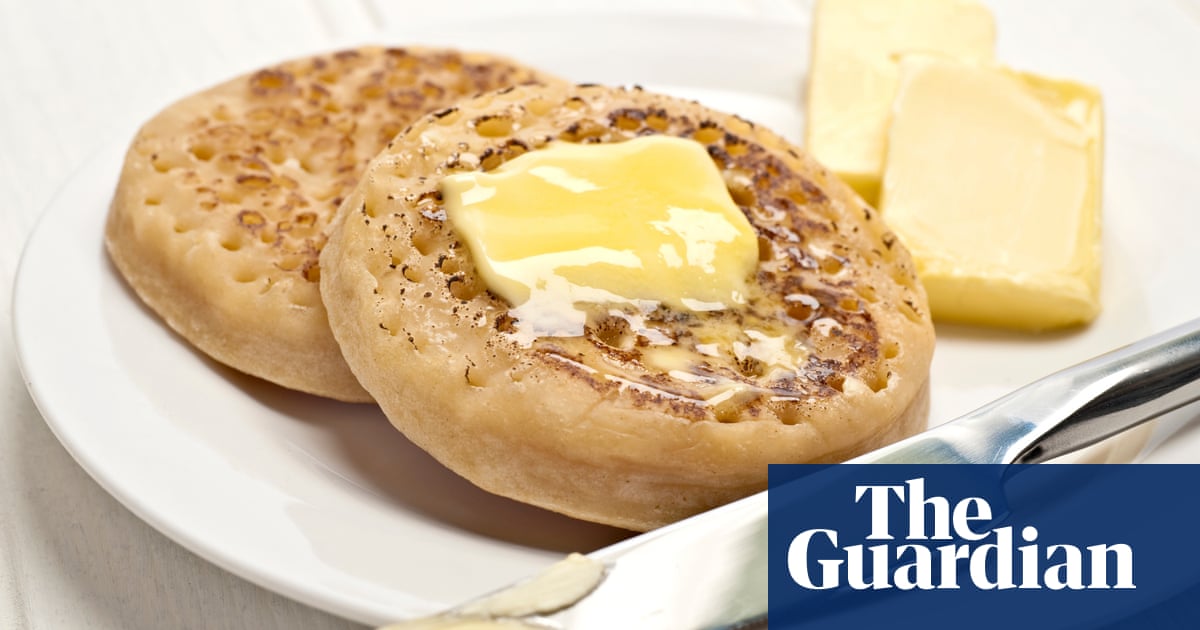From crumpets to pies to ham and cheese toasties, restaurants are replacing challenging dishes with those that remind us of home and childhood. Why is this change happening now?

It was the crumpet that did it. Sure, the mackerel pat was mesmerising, the pickled oyster piquant and the brill terrine as dazzling as its name suggests. But, as we half-rolled out of Cornerstone seafood restaurant in east London, the crumpet was what sank into our memory dripping with butter and laden with small, sweetly savoury potted shrimps.
It was our childhood or, at least, the crumpet was: its buttery lattice and doughy insides up there with Live and Kicking as a highlight of Saturday mornings. It was comfort food: fat, carbohydrate and nostalgia together with a palpable sense of home.
It is what all food should be, says Cornerstones owner, Tom Brown. Food you crave, that you want to dive straight into. I dont want you to read our menu and think: What is that? I want you to think: I want that! While the era of esoteric menus shows no signs of ending (see Natives pea pod ice cream with wood ants, say, or lEnclumes aged veal in coal oil) Brown is increasingly not alone in rejecting these modish, challenging dishes in favour of food that resonates and restores.
I have definitely noticed a surge in comfort food dishes appearing on restaurant menus, says the chef George Barson of Cora Pearl in Covent Garden. His menu is a luxury tour of Britains comfort food highlights: faggots and peas, bubble and squeak risotto and a ham and cheese toastie Barson describes as completely recognisable and not trying to be anything other than what it is. This is comfort food not as chefs of the 00s had it disdained, or so deconstructed as to be unrecognisable but perfected and polished, with quality ingredients. We arent bringing back the original rubbish, highly processed versions of 80s and 90s comfort food, observes the food historian Angela Clutton. The generation of chefs opening restaurants now are those thinking: We loved those foods when we were younger lets make good ones, with our newfound respect for quality and provenance.

Historically, the concept of comfort food has little precedence. The have-nots ate what they could afford, while those who had ate as lavishly as they could so as to distinguish themselves. Food was classist rather than emotive, says Clutton. You and I know if we have a chocolate hobnob, we will feel better afterwards, but I dont know if, in the past, people would have articulated that feeling. From a historical perspective, the closest comparison comes from the mid-Victorian era, when middle-class families were moving to cities and cookery writers such as Mrs Beeton introduced an element of rural nostalgia to their books to help housewives feel connected to their pastoral upbringings. This was one of the earliest examples of cookbooks offering emotional as well as practical support.
It is a pattern echoed by Nigella Lawson in her book Feast, in which she used recipes to navigate lifes highs and lows, by Diana Henry in Roast Figs Sugar Snow and by Laura Goodman in Carbs, her love letter to carbohydrates. Weve tried to hide it, shoving carbs aside for cauliflower rice and courgetti, but were not fooling anyone. Carbs are what we want what we really, really want, Goodman writes by way of introduction to recipes such as spaghetti and meatballs, challah bread and hash browns.
Of course, your comfort food might not feature carbohydrates. As Clutton points out, comfort food is not just about social food history, but your personal food history the food of your childhood. Nevertheless, there is a palpable physiological link between sinking your face into a steaming bowl of mashed potato or sticky coconut rice and feeling sated and content. There was a book years ago called Potatoes not Prozac that advised people with depression to eat more carbohydrates because they are a real mood-enhancer, says the psychologist and writer Amanda Hills. They make you sleep better and they encourage an upsurge in serotonin. She believes there is a connection between the rise in comfort food and our collective anxiety. Its part of a larger trend toward regressing slightly away from what people see as an uncertain world toward something that makes them feel safe.
Hills notes with interest that the generation most likely to eat out now late 20s, early 30s, no kids are the same generation who are most likely to tell her they are worried about politics and the climate crisis. They report to me their concerns about Brexit and Trumps America. In these times a comforting meal can take them briefly back to childhood, in much the same way as the remakes of the Disney films they grew up with. These are constants in a world of rapid, frightening changes even if, like Aladdin and Browns crumpet, they have been updated slightly for todays more sophisticated palates.
Proust was spot on when he described the childhood memories induced by the madeleine: Taste and smell are tied up with memory: they occupy the same area of the brain, the hippocampus, Hills says. As Calum Franklin, the executive chef at Holborn Dining Rooms in London, says of his celebrated, golden-crusted pies: It is a good way to bring back childhood memories of the family table and, in a way, give diners a break from the pressures and uncertainties that surround us.
To the extent that he was calling for the end of molecular gastronomy or the Scandi foraged stuff, Brown was exaggerating for effect. There are chefs who do this amazingly well who are leaders in their field, he says. The discomfort food (as he calls it) comes when less-skilled chefs make a hash of haute cuisine neither nourishing nor innovative, warming or wow. In previous years, chefs looking to earn a Michelin star have automatically reached for such novelties. Yet, if you look across the world, all the best cuisines are steeped in heritage, in people cooking the same way for generations, Brown says. Take a snapshot of popular food trends, and it is ramen bars, pasta restaurants, dumplings, biangbiang noodles and pies.

Comfort food is something that has to be fresh and eaten when still hot, proclaims Kasia Hitchcock, the co-owner of the tiny, critically acclaimed Sparrows in Manchester. The sptzle and dumplings of her partner Franco Conclis Tyrolean heritage are simple, honest and tasty food that serves its purpose of regenerating mind and soul as well as providing rest from urban living: a purpose that would doubtless have made Mrs Beeton proud. There is a universality to comfort food, in that regardless of class, creed or country, there is a cheese-smothered, oil-oozing, salty-sweet carbfest for every culture.
Chefs favourite comfort foods
Tom Oldroyd of Oldroyd/Duke of Richmond, London At home, Ill probably make an Indian lentil and egg curry, or roast a whole chicken with all the trimmings.
Romy Gill of Roms Kitchen, Bristol Cheese on toast and it has to be white bread. It takes me back to my childhood. I didnt have it while growing up in India, yet somehow theres a connection. It gives me joy and comfort and fills me up.
Jacob Kennedy of Plaquemine Lock, London For me, its food with soul. Whether its a French cassoulet, Italian tagliatelle al ragu, an English pie, Cajun gumbo or Creole jambalaya, its food that tells a story of home and hearth and welcome.
Franco Concli of Sparrows, Manchester I am from Trentino in Italy and whenever we travel there are always gnocchi to welcome us home.
George Barson of Cora Peal/Kitty Fishers, London My ultimate comfort food is toast thickly cut and served with slightly cold salty butter spread unevenly, so that every now and then you bite through a cold layer of butter into the hot toast beneath. Not only is it delicious; the smell is so instantly comforting, nostalgic and homely.
Ravinder Bhogal of Jikoni, London I cook scrag end of mutton slowly overnight with warming spices like cinnamon and black cardamom, then top it with a thick layer of spice-infused creamy mash – enough to insulate an igloo to make scrag end pie.
Selin Kiazim of Oklava/Kyseri, London It has to be a proper kebab at the Kiazim household, full of smoky lamb chops, chicken and fresh salads.
Roy Brett of Ondine, Edinburgh One of my favourite dishes is dressed brown crab and buttered crumpets. These beautifully simple components are the ultimate comfort food but its the care, precision and top-quality ingredients that go into the dish that make the difference.


Recent Comments